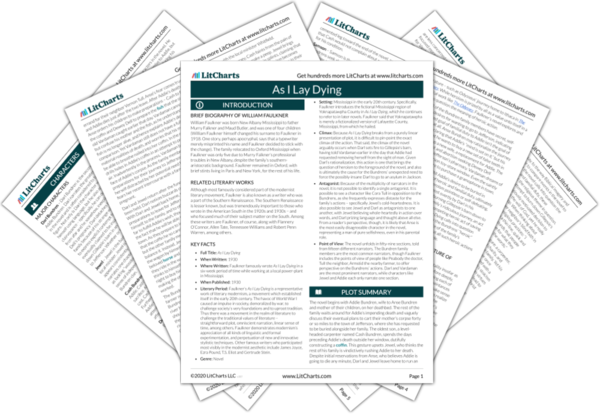Welcome to the LitCharts study guide on William Faulkner's As I Lay Dying. Created by the original team behind SparkNotes, LitCharts are the world's best literature guides.
As I Lay Dying: Introduction
A concise biography of William Faulkner plus historical and literary context for As I Lay Dying.
As I Lay Dying: Plot Summary
A quick-reference summary: As I Lay Dying on a single page.
As I Lay Dying: Detailed Summary & Analysis
In-depth summary and analysis of every chapter of As I Lay Dying. Visual theme-tracking, too.
As I Lay Dying: Themes
Explanations, analysis, and visualizations of As I Lay Dying's themes.
As I Lay Dying: Quotes
As I Lay Dying's important quotes, sortable by theme, character, or chapter.
As I Lay Dying: Characters
Description, analysis, and timelines for As I Lay Dying's characters.
As I Lay Dying: Symbols
Explanations of As I Lay Dying's symbols, and tracking of where they appear.
As I Lay Dying: Theme Wheel
An interactive data visualization of As I Lay Dying's plot and themes.
Brief Biography of William Faulkner
William Faulkner was born New Albany Mississippi to father Murry Falkner and Maud Butler, and was one of four children (William Faulkner himself changed his surname to Faulkner in 1918. One story, perhaps apocryphal, says that a typewriter merely misprinted his name and Faulkner decided to stick with the change). The family relocated to Oxford Mississippi when Faulkner was only five due to Murry Falkner’s professional troubles in New Albany, despite the family’s southern-aristocratic background. Faulkner remained in Oxford, with brief stints living in Paris and New York, for the rest of his life.
Get the entire As I Lay Dying LitChart as a printable PDF.

Other Books Related to As I Lay Dying
Although most famously considered part of the modernist literary movement, Faulkner is also known as a writer who was a part of the Southern Renaissance. The Southern Renaissance is lesser known, but was tremendously important to those who wrote in the American South in the 1920s and 1930s – and who focused much of their subject matter on the South. Among these writers are Faulkner, of course, along with Flannery O’Connor, Allen Tate, Tennessee Williams and Robert Penn Warren, among others.
Key Facts about As I Lay Dying
- Full Title: As I Lay Dying
- When Written: 1930
- Where Written: Faulkner famously wrote As I Lay Dying in a six-week period of time while working at a local power-plant in Mississippi.
- When Published: 1930
- Literary Period: Faulkner’s As I Lay Dying is a representative work of literary modernism, a movement which established itself in the early 20th century. The havoc of World War I caused an impulse in society, demoralized by war, to challenge society’s very foundations and to uproot tradition. Thus there was a movement in the realm of literature to challenge the traditional values of literature – straightforward plot, omniscient narration, linear sense of time, among others. Faulkner demonstrates modernism’s appreciation of all kinds of linguistic and formal experimentation, and perpetuation of new and innovative stylistic techniques. Other famous writers who participated most visibly in the modernist aesthetic include James Joyce, Ezra Pound, T.S. Eliot and Gertrude Stein.
- Genre: Novel
- Setting: Mississippi in the early 20th century. Specifically, Faulkner introduces the fictional Mississippi region of Yoknapatawpha County in As I Lay Dying, which he continues to refer to in later novels. Faulkner said that Yoknapatawpha is merely a fictionalized version of Lafayette County, Mississippi, from which he hailed.
- Climax: Because As I Lay Dying breaks from a purely linear presentation of plot, it is difficult to pin-point the exact climax of the action. That said, the climax of the novel arguably occurs when Darl sets fire to Gillepsie’s barn, having told Vardaman earlier in the day that Addie had requested removing herself from the sight of man. Given Darl’s rationalization, this action is one that brings the question of heroism to the foreground of the novel, and also is ultimately the cause for the Bundrens’ unexpected need to force the possibly-insane Darl to go to an asylum in Jackson.
- Antagonist: Because of the multiplicity of narrators in the novel, it is not possible to identify a single antagonist. It is possible to see a character like Cora Tull in opposition to the Bundrens, as she frequently expresses distaste for the family’s actions – specifically Jewel’s cold-heartedness. It is also possible to see Jewel and Darl as antagonists to one another, with Jewel believing whole-heartedly in action over words, and Darl prizing language and thought above all else. From a reader’s perspective, though, it is likely that Anse is the most easily disagreeable character in the novel, representing a man of pure selfishness, even in his parental role.
- Point of View: The novel unfolds in fifty-nine sections, told from fifteen different narrators. The Bundren family members are the most common narrators, though Faulkner includes the points of view of people like Peabody the doctor, Tull the neighbor, Armstid the nearby farmer, to offer perspective on the Bundrens’ actions. Darl and Vardaman are the most prominent narrators, while characters like Jewel and Addie each only narrate one section.












